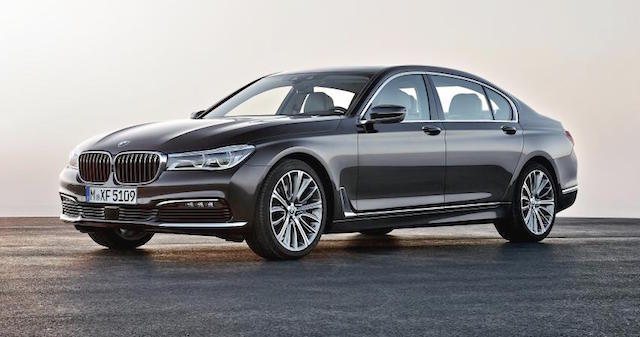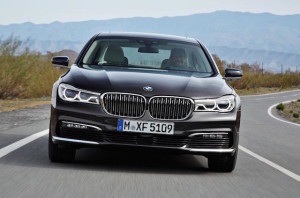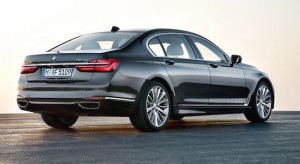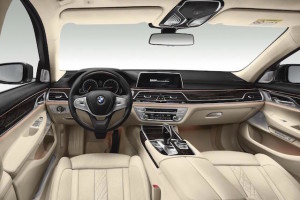
 The first official pictures of the new BMW 7-Series saloon clearly show that the carmaker has played it safe and followed an evolutionary design line rather than an overall rethink.
The first official pictures of the new BMW 7-Series saloon clearly show that the carmaker has played it safe and followed an evolutionary design line rather than an overall rethink.
The new flagship will land in New Zealand next year and reveal a profile that is almost identical to the outgoing model. So, too, the design up front, with the prominent kidney grille and nose. Same with the rear end and its strong styling.
 What marks both front and rear ends as new are the lights – ‘Laserlight’ beams up front in a headlight assembly that butts up against the grille, and LEDs at the rear.
What marks both front and rear ends as new are the lights – ‘Laserlight’ beams up front in a headlight assembly that butts up against the grille, and LEDs at the rear.
The new 7-Series might indeed resemble its predecessor, but within the car’s dimensions is more room for occupants. Height and width are pretty much identical but overall length is up by 26mm in the standard car and a full 140mm in the long-wheelbase variant. The boot in the LWB offers 515 litres of space.
 But although the new model is bigger, it is 130kg lighter, thanks mostly to the use of carbon-fibre reinforced plastic (CFRP) for the passenger cell and body. The engines are lighter, too.
But although the new model is bigger, it is 130kg lighter, thanks mostly to the use of carbon-fibre reinforced plastic (CFRP) for the passenger cell and body. The engines are lighter, too.
The only engine options at launch for the 7-Series are six-cylinder units, with a 243kW 3.0-litre twin-turbo petrol in the 740LI and the 197kW 730D with 620Nm of torque. A hybrid model is badged the 740e and offers claimed fuel use of 2.1 litres/100km, or 134mpg. Four-wheel drive is also available across the range.
 The cabin layout also looks like the old car, the only immediately noticeable design change is a free-standing infotainment screen on the dash. The standard screen is smaller than the 26cm professional option. But it’s the role of the screen that’s the big news.
The cabin layout also looks like the old car, the only immediately noticeable design change is a free-standing infotainment screen on the dash. The standard screen is smaller than the 26cm professional option. But it’s the role of the screen that’s the big news.
For the first time it’s a touchscreen that works with the iDrive rotary knob. Another first is “interactive traffic sign updating”, which works with the ConnectedDrive service. Yet another is “gesture control” that works via a 3D sensor in the touchscreen. It allows the driver to make hand movements to alter in-car functions.
 The instrument cluster is a multifunctional system, changing when the driver engages different modes, like moving from ‘comfort’ to ‘sport’, for instance. ? ‘Executive Drive Pro’ combines adaptive dampers and air suspension to actively remove body roll and smoothen the ride.
The instrument cluster is a multifunctional system, changing when the driver engages different modes, like moving from ‘comfort’ to ‘sport’, for instance. ? ‘Executive Drive Pro’ combines adaptive dampers and air suspension to actively remove body roll and smoothen the ride.
Four-zone climate control is standard across the range, with a touch control panel between the rear seats allowing adjustment of temperature and the rear media interface. An optional Heat Comfort system allows the wheel, front and rear armrests and front and rear seats to be warmed individually, while new ambient lighting adorns the cabin.
Other gizmos include wireless phone charging, active massaging seats, WiFi browsing and a removeable 18cm tablet that can control functions from in our outside the car. There’s even the option of an ‘Ambient Air’ package, which releases a choice of eight controlled scents into the cabin and ionises the air.
The neatest feature is another world first. ‘Parking Assistant’ allows the car to manoeuvre in out out of forward parking or garage spaces without the driver even stepping inside. It can be activated remotely with the new ‘Display Key’.
